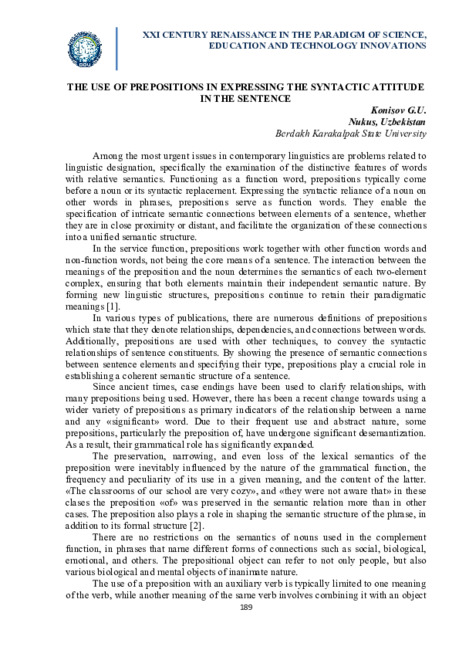
XXI CENTURY RENAISSANCE IN THE PARADIGM OF SCIENCE,
EDUCATION AND TECHNOLOGY INNOVATIONS
189
THE USE OF PREPOSITIONS IN EXPRESSING THE SYNTACTIC ATTITUDE
IN THE SENTENCE
Konisov G.U.
Nukus, Uzbekistan
Berdakh Karakalpak State University
Among the most urgent issues in contemporary linguistics are problems related to
linguistic designation, specifically the examination of the distinctive features of words
with relative semantics. Functioning as a function word, prepositions typically come
before a noun or its syntactic replacement. Expressing the syntactic reliance of a noun on
other words in phrases, prepositions serve as function words. They enable the
specification of intricate semantic connections between elements of a sentence, whether
they are in close proximity or distant, and facilitate the organization of these connections
into a unified semantic structure.
In the service function, prepositions work together with other function words and
non-function words, not being the core means of a sentence. The interaction between the
meanings of the preposition and the noun determines the semantics of each two-element
complex, ensuring that both elements maintain their independent semantic nature. By
forming new linguistic structures, prepositions continue to retain their paradigmatic
meanings [1].
In various types of publications, there are numerous definitions of prepositions
which state that they denote relationships, dependencies, and connections between words.
Additionally, prepositions are used with other techniques, to convey the syntactic
relationships of sentence constituents. By showing the presence of semantic connections
between sentence elements and specifying their type, prepositions play a crucial role in
establishing a coherent semantic structure of a sentence.
Since ancient times, case endings have been used to clarify relationships, with
many prepositions being used. However, there has been a recent change towards using a
wider variety of prepositions as primary indicators of the relationship between a name
and any «significant» word. Due to their frequent use and abstract nature, some
prepositions, particularly the preposition of, have undergone significant desemantization.
As a result, their grammatical role has significantly expanded.
The preservation, narrowing, and even loss of the lexical semantics of the
preposition were inevitably influenced by the nature of the grammatical function, the
frequency and peculiarity of its use in a given meaning, and the content of the latter.
«The classrooms of our school are very cozy», and «they were not aware that» in these
clases the preposition «of» was preserved in the semantic relation more than in other
cases. The preposition also plays a role in shaping the semantic structure of the phrase, in
addition to its formal structure [2].
There are no restrictions on the semantics of nouns used in the complement
function, in phrases that name different forms of connections such as social, biological,
emotional, and others. The prepositional object can refer to not only people, but also
various biological and mental objects of inanimate nature.
The use of a preposition with an auxiliary verb is typically limited to one meaning
of the verb, while another meaning of the same verb involves combining it with an object

XXI CENTURY RENAISSANCE IN THE PARADIGM OF SCIENCE,
EDUCATION AND TECHNOLOGY INNOVATIONS
190
using a different preposition. Different prepositions can be fixed to the same verb,
conveying different relationships in the same meaning of the verb.
The function of a noun as a prepositional object of a verb relies on the actual
relationships between objects and actions present in reality, as well as the real-life
situations in which these relationships occur. In this particular scenario, the type of action
being performed dictates the type of means used for the certain context. Simultaneously,
the chosen means serves as an integral component of the action’s implementation. The
aforementioned considerations are taken into account when selecting the lexical units that
compose the analyzed phrases within their respective contexts.
Prepositions assigned to specific lexical units can be used analogously with other
lexical units to express the same meaning.
Prepositions serve the purpose of forming the semantic structure of a statement,
establishing various types of relationships between its elements. These relationships are
so general that they can exist between linguistic units of diverse semantics.
The selection of a preposition, or sometimes even a single word, is not determined
by the semantics of individual units within a phrase. Rather, it is the overall semantic
interaction of all elements in the statement, including both fundamental and explanatory
components, that forms the final meaning.
REFERENCES:
1. Hornby A.S. The teaching of structural words and sentence pattern. Stage 1-2. London,
1961.
2. Ibid. Modern descriptive English grammar. San Francisco, 1972.
3. Atashova F. D., Konisov G. U. THE CONCEPT OF COMPETENCE APPROACH IN
TEACHING
A
FOREIGN
LANGUAGE
ЧЕТ
ТИЛИНИ
ЎҚИТИШДА
КОМПЕТЕНЦИЯ ЁНДАШУВИ ТУШУНЧАСИ //Mental Enlightenment Scientific-
Methodological Journal. – 2022. – Т. 2022. – №. 2. – С. 24-37.
4. Feruza A., Dilbar P., Firuza D. CENTRAL ASIAN JOURNAL OF THEORETICAL
AND APPLIED SCIENCES. – 2021.
5. Atashova F., Konratbaeva E. CULTURE SHOCK AS THE BARRIER OF
PERSONAL DEVELOPMENT IMPACTS PSYCHOLOGY OF PEOPLE //WORLD
SCIENCE: PROBLEMS AND INNOVATIONS. – 2019. – С. 172-174.
6. Atashova F. D., Seytniyazova G. M. DEVELOPING COMMUNICATIVE
COMPETENCE
OF
ESP
LEARNERS
ESP
ЎҚУВЧИЛАРИНИНГ
КОММУНИКАТИВ
КОМПЕТЕНЦИЯСИНИ
РИВОЖЛАНТИРИШ
//Mental
Enlightenment Scientific-Methodological Journal. – 2022. – Т. 2022. – №. 2. – С. 38-50.
7. Sadullaeva A. “TERBENBES” ROMANÍNDA ‘MUHABBAT’TÚSINIGI //Science
and innovation. – 2022. – Т. 1. – №. B8. – С. 1957-1961.
8. Садуллаева А. Concept―muhabbat in Karakalpak proverbs //Современные
инновационные исследования актуальные проблемы и развитие тенденции:
решения и перспективы. – 2022. – Т. 1. – №. 1. – С. 616-617.






